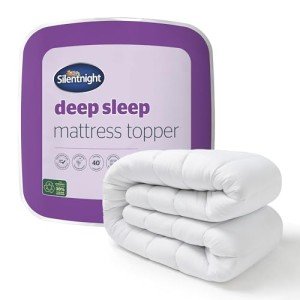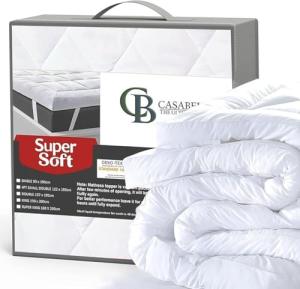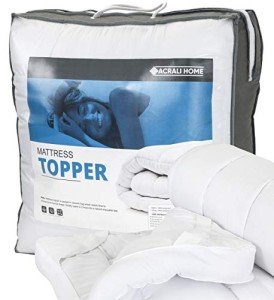A good night’s sleep is pivotal for overall well-being, and having the right mattress topper plays a significant role in achieving this. One of the most sought-after products in the bedding industry today is the super soft hypoallergenic mattress topper. These toppers not only enhance comfort but also cater to specific needs such as allergies. In this comprehensive guide, we will explore the benefits, features, and frequently asked questions about these remarkable sleep accessories.
What is a Mattress Topper?
A mattress topper is an additional layer of cushioning placed on top of a mattress to improve its comfort and support. Mattress toppers come in various materials, including memory foam, latex, and polyester. Their primary purpose is to adjust the firmness level of a mattress, offer support, and enhance overall sleep quality.
Benefits of a Super Soft Hypoallergenic Mattress Topper
-
Enhanced Comfort: The most significant advantage of these toppers is the luxurious softness and comfort they provide. They mold to the body’s contours, reducing pressure points and alleviating discomfort during sleep.
-
Hypoallergenic Properties: Many people experience sleep disturbances due to dust mites, mold, and other allergens. Hypoallergenic mattress toppers are designed with materials that resist allergens, creating a healthier sleep environment.
-
Temperature Regulation: Some hypoallergenic mattress toppers feature temperature-regulating technologies, keeping sleepers cool in the summer and warm in the winter. This helps to achieve a more restful sleep.
-
Extend Mattress Life: By using a mattress topper, you can enhance your old or worn mattress's durability, delaying the need for an expensive replacement.
-
Cost-Effective Solution: Buying a high-quality mattress topper is a budget-friendly alternative to purchasing a new mattress, providing similar benefits at a fraction of the cost.
Key Features to Consider
When selecting a super soft hypoallergenic mattress topper, several factors should be taken into consideration. Below is a list of essential features to look for:
- Material: Common materials include memory foam, latex, and microfiber. Each offers unique benefits, so understanding how they meet individual needs is important.
- Certifications: Look for certifications such as CertiPUR-US® for foam products, ensuring no harmful chemicals are used.
- Thickness: Mattress toppers generally range from 2 to 4 inches in thickness. Thicker toppers often provide more cushioning and support.
- Density: The density of the foam impacts both comfort and durability. High-density foam tends to be more durable and supportive.
- Cover: A removable and washable cover adds convenience and hygiene, especially for hypoallergenic products.
- Warranty: A longer warranty often indicates higher quality. Check the warranty terms to ensure you are protected.
Comparison Table of Common Mattress Topper Materials
| Material | Comfort Level | Hypoallergenic | Durability | Temperature Regulation |
|---|---|---|---|---|
| Memory Foam | High | Yes | Moderate | Moderate |
| Latex | Moderate/High | Yes | High | Excellent |
| Microfiber | Moderate | Yes | Low | Poor |
| Gel-infused Foam | High | Yes | Moderate | Excellent |
How to Choose the Right Mattress Topper
Selecting the right mattress topper involves personal preferences and specific needs. Here’s a step-by-step guide to help in the decision-making process:
- Assess Your Needs: Identify why you want a mattress topper (e.g., alleviate pressure, reduce allergens, etc.).
- Determine Budget: Establish a price range that aligns with your financial capabilities.
- Research Products: Investigate different brands and materials available in the market. Read reviews and ratings.
- Try Before You Buy: If possible, visit a store to test the mattress topper for comfort and support.
- Check for Guarantees: Many companies offer trial periods or returns; make sure to understand the policies before purchasing.
FAQs About Super Soft Hypoallergenic Mattress Toppers
1. How do I maintain my hypoallergenic mattress topper?
Regular cleaning is essential for maintaining a hypoallergenic mattress topper. Most toppers come with removable covers that can be machine washed. Follow the manufacturer’s care instructions to ensure longevity.
2. Can I use a mattress topper on an old mattress?
Yes, a mattress topper can breathe new life into an old bed by providing additional comfort and support. However, if the mattress is severely worn or damaged, it may be time for a replacement.
3. Are hypoallergenic mattress toppers safe for children?
Yes, hypoallergenic mattress toppers are generally safe for children, but ensure that the materials used are free from harmful chemicals. Always check for certifications and reviews.
4. How long does a mattress topper typically last?
The lifespan of a mattress topper depends on its materials and care, but most high-quality hypoallergenic toppers last between three to five years with proper maintenance.
5. Can a mattress topper help with back pain?
Many users find relief from back pain after using a mattress topper that suits their comfort needs. A soft hypoallergenic topper can provide additional support and alignment for the spine.
Super soft hypoallergenic mattress toppers offer an excellent solution for enhancing sleep quality. With their unique blend of comfort and allergy resistance, these toppers cater to a diverse spectrum of sleep needs. As you consider investing in one, keep in mind the important features to look for and how to maintain your topper for the best results. With the right product, a restful night’s sleep is just a topper away.






